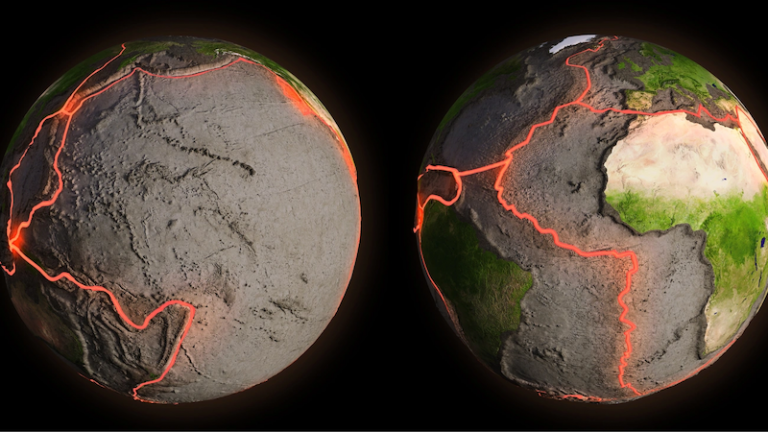For centuries, scientists believed Earth’s surface was fixed and unchanging. Mountains were thought to rise in place, oceans to stay permanently where they had formed, and continents to remain immobile. The idea that the ground beneath our feet could move was almost unimaginable. Yet one discovery transformed the entire understanding of our planet: the theory of plate tectonics.
Today, plate tectonics stands as one of the most important scientific breakthroughs in Earth science—a framework that explains earthquakes, volcanoes, mountain formation, ocean basins, and even the evolution of life. But this discovery didn’t emerge overnight. It took decades of curiosity, skepticism, scientific battles, and overwhelming evidence for the world to finally accept that the Earth is, quite literally, in motion.
The Birth of a Revolutionary Idea
The story begins in 1912 when German meteorologist Alfred Wegener proposed “continental drift.” He noticed that continents like South America and Africa seemed to fit together like puzzle pieces. Fossils of the same species appeared on continents separated by oceans. Mountain ranges in North America aligned perfectly with ones in Europe.
Wegener believed all continents once formed a supercontinent he called Pangaea, which slowly drifted apart.
Although visionary, Wegener lacked one crucial explanation: What force moved the continents?
His theory was dismissed for decades [1].
The Earth Speaks Through the Ocean Floor
It wasn’t until the mid-20th century—during deep-sea explorations and post-war research—that scientists discovered something astonishing:
- The ocean floor was spreading apart.
- New crust was forming at mid-ocean ridges.
- Old crust was sinking back into the mantle at deep trenches.
This process, known as seafloor spreading, provided the missing mechanism Wegener had lacked. The continents weren’t plowing through oceanic crust—they were riding on top of massive slabs of rock moved by convection currents inside Earth.
The puzzle finally made sense.
What Is Plate Tectonics?
Plate tectonics explains that Earth’s lithosphere (the rigid outer layer) is divided into large and small plates. These plates float on the semi-fluid asthenosphere beneath and move slowly—just a few centimeters per year.
Their interactions shape the entire planet:
1. Divergent Boundaries – Where Plates Split Apart
These boundaries create mid-ocean ridges, rift valleys, and new crust. The Atlantic Ocean continues to widen this way today.
2. Convergent Boundaries – Where Plates Collide
Here, mountains rise, trenches form, and volcanic arcs emerge. The Himalayas exist because India collided with Asia.
3. Transform Boundaries – Plates Sliding Past Each Other
The San Andreas Fault in California is a classic example, where massive earthquakes occur because of horizontal plate movement.
Plate tectonics unified geology the way evolution unified biology.
How Plate Tectonics Transformed Science
1. A New Explanation for Earthquakes and Volcanoes
Before plate tectonics, earthquakes and volcanoes seemed randomly scattered. Now scientists know they cluster along plate boundaries. This understanding helps in hazard assessment and disaster preparedness.
2. Understanding Mountain Formation
Mountains aren’t permanent fixtures—they rise, collapse, and reshape over millions of years. Plate tectonics explains why ranges like the Himalayas are still growing today [2].
3. Mapping the Planet’s Past
With plate movements, scientists can reconstruct ancient Earth, revealing a world where continents collided, separated, and even switched poles. This deep-time perspective helps explain climate changes, mass extinctions, and species evolution.
4. Predicting the Future of Continents
Plate tectonics allows geologists to model Earth’s future. In 200 million years, Africa may collide with Europe, closing the Mediterranean Sea and forming new mountains.
5. Linking Life and Earth Systems
Movements of continents influenced ocean currents, climate zones, and habitats—key drivers in the evolution of life. Plate tectonics is not just a geological concept; it’s a biological one too.
The Human Side of a Scientific Revolution
Like all great scientific revolutions, plate tectonics faced resistance. Wegener was ridiculed during his lifetime. Many geologists dismissed his ideas simply because they challenged long-held beliefs.
Yet science thrives on bold questions—and Wegener’s question changed the world.
By the 1960s, overwhelming evidence from oceanography, seismology, paleomagnetism, and geology forced the scientific community to accept the truth:
Earth’s crust moves, shifts, breaks, and rebuilds itself.
The world had a new scientific language to explain its dynamic processes.
A Living, Breathing Planet
Plate tectonics reminds us that Earth is not static but alive—reshaping itself constantly. The landscapes we know today are temporary chapters in a much longer geological story.
Mountains rise and fall. Oceans open and close. Continents merge and break apart.
Every earthquake we feel, every volcanic eruption we witness, every mountain we climb is part of a deeper planetary rhythm.
FAQ
What is plate tectonics in simple terms?
Plate tectonics is the scientific theory that Earth’s outer shell (the lithosphere) is broken into large plates that slowly move over the semi-molten layer beneath. These plates interact—colliding, separating, or sliding past each other—causing earthquakes, volcanoes, mountains, and ocean formation. It explains why Earth’s surface is constantly changing.
How did plate tectonics originate as a scientific idea?
The idea began with Alfred Wegener’s early 20th-century theory of continental drift, which suggested continents were once joined and have since drifted apart. Although he lacked proof of how they moved, later discoveries like seafloor spreading, magnetic stripes on ocean floors, and deep-sea trenches provided the mechanism. This combined evidence evolved into the modern theory of plate tectonics by the 1960s.
What evidence supports the theory of plate tectonics?
There are multiple lines of strong scientific evidence, including:
GPS measurements showing continents still moving
These proofs made plate tectonics the most accepted geological theory today.
Matching fossils across continents
Similar rock formations across oceans
Seafloor spreading seen at mid-ocean ridges
Earthquake and volcano patterns along plate boundaries
How does plate tectonics create earthquakes and volcanoes?
Most earthquakes and volcanoes occur at plate boundaries. When plates collide, pull apart, or grind against each other, immense stress builds up. This stress releases as earthquakes. Similarly, gaps created at divergent boundaries or melting at convergent boundaries allow magma to rise, forming volcanoes. That’s why places like Japan, Indonesia, and California experience so much seismic activity.
How does plate tectonics affect the formation of mountains?
Mountains form mainly at convergent boundaries, where two plates collide. When two continental plates push together—like India and Asia—they crumple and rise to form massive ranges such as the Himalayas. These mountains continue to grow every year as the plates keep moving. Volcanic mountains like the Andes also form when oceanic plates sink beneath continental ones.
Why was the discovery of plate tectonics so important for geology?
Before plate tectonics, geology had isolated explanations for earthquakes, mountains, fossils, and rocks. Plate tectonics provided a single, unified framework that explained all these phenomena. It revolutionized research, connected geology with earth systems, and transformed how scientists understand Earth’s past, present, and future. It is considered as significant to geology as evolution is to biology.
How does plate tectonics impact the future of Earth?
Plate movement continues today, meaning continents will keep shifting for millions of years. Scientists predict that Africa will merge with Europe, the Atlantic Ocean will widen further, and a new supercontinent may form in 200–250 million years. Plate tectonics also influences long-term climate patterns, ocean circulation, and the evolution of life—shaping Earth’s future just as it shaped its past.
Final Thought
The theory of plate tectonics is a rare scientific breakthrough that didn’t just solve one mystery—it solved hundreds at once. It unified geology into a coherent, elegant explanation of Earth’s past, present, and future. It reshaped how humanity understands the planet beneath its feet. And it stands as a testament to the power of curiosity, persistence, and evidence like Kapdec does.
The ground below us is not fixed—it’s alive, moving, and shaping our world in ways we’re still learning to understand.



